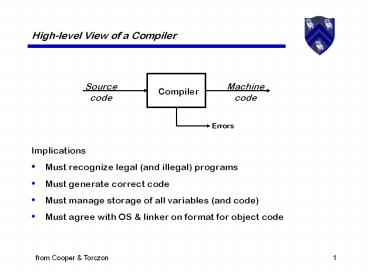Implications PowerPoint PPT Presentation
Title: Implications
1
High-level View of a Compiler
- Implications
- Must recognize legal (and illegal) programs
- Must generate correct code
- Must manage storage of all variables (and code)
- Must agree with OS linker on format for object
code
2
Traditional Two-pass Compiler
- Implications
- Use an intermediate representation (IR)
- Front end maps legal source code into IR
- Back end maps IR into target machine code
- Admits multiple front ends multiple passes
(better code) - Typically, front end is O(n) or O(n log n), while
back end is NPC
3
A Common Fallacy
- Can we build n x m compilers with nm components?
- Must encode all language specific knowledge in
each front end - Must encode all features in a single IR
- Must encode all target specific knowledge in each
back end - Limited success in systems with very low-level IRs
4
The Front End
- Responsibilities
- Recognize legal ( illegal) programs
- Report errors in a useful way
- Produce IR preliminary storage map
- Shape the code for the back end
- Much of front end construction can be automated
5
The Front End
- Scanner
- Maps character stream into wordsthe basic unit
of syntax - Produces words their parts of speech
- x x y becomes ltid,xgt ltop, gt ltid,xgt
ltop, ltid,ygt - word ? lexeme, part of speech ? token
- In casual speech, we call the pair a token
- Typical tokens include number, identifier, , -,
while, if - Scanner eliminates white space
- Speed is important ?use a specialized recognizer
6
The Front End
- Parser
- Recognizes context-free syntax reports errors
- Guides context-sensitive analysis (type checking)
- Builds IR for source program
- Hand-coded parsers are fairly easy to build
- Most books advocate using automatic parser
generators
7
The Front End
- Compilers often use an abstract syntax tree
- This is much more concise
- ASTs are one form of intermediate representation
(IR)
The AST summarizes grammatical structure, without
including detail about the derivation
8
The Back End
- Responsibilities
- Translate IR into target machine code
- Choose instructions to implement each IR
operation - Decide which value to keep in registers
- Ensure conformance with system interfaces
- Automation has been much less successful in the
back end
9
The Back End
- Instruction Selection
- Produce fast, compact code
- Take advantage of target features such as
addressing modes - Usually viewed as a pattern matching problem
- ad hoc methods, pattern matching, dynamic
programming - This was the problem of the future in 1978
- Spurred by transition from PDP-11 to VAX-11
- Orthogonality of RISC simplified this problem
10
The Back End
- Instruction Scheduling
- Avoid hardware stalls and interlocks
- Use all functional units productively
- Can increase lifetime of variables
(changing the allocation) - Optimal scheduling is NP-Complete in nearly all
cases - Good heuristic techniques are well understood
11
The Back End
- Register allocation
- Have each value in a register when it is used
- Manage a limited set of resources
- Can change instruction choices insert LOADs
STOREs - Optimal allocation is NP-Complete
(1 or k registers) - Compilers approximate solutions to NP-Complete
problems
12
Traditional Three-pass Compiler
- Code Improvement (or Optimization)
- Analyzes IR and rewrites (or transforms) IR
- Primary goal is to reduce running time of the
compiled code - May also improve space, power consumption,
- Must preserve meaning of the code
- Measured by values of named variables
13
The Optimizer (or Middle End)
- Typical Transformations
- Discover propagate some constant value
- Move a computation to a less frequently executed
place - Discover a redundant computation remove it
- Remove useless or unreachable code
Modern optimizers are structured as a series of
passes

